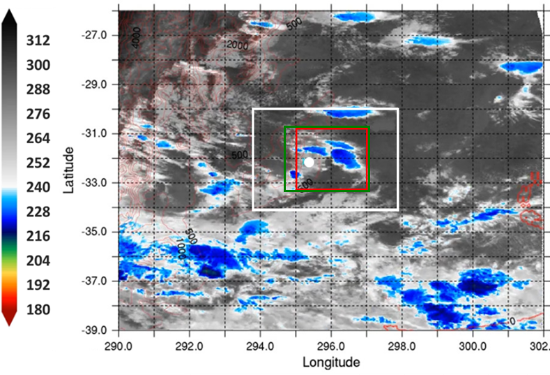Case Description: 5 December 2018
Summary
Three cells initiate and grow near the AMF into small sizes
Description
Convection early during the day clears out of the region by 10 UTC and convective initiations start by 17 UTC. By 19:45 UTC, three cells develop and grow to the north of the AMF and one to the southwest behind the ridgeline (not observable by the CSAPR2). CAPE values are in the lower third of their ranges (at 18 UTC MUCAPE=823; MLCAPE=519 J kg-1).
Available assets
CSAPR2, G1 flight, GOES rapid scan, RELAMPAGO mission (35 soundings), CSU C-Band data
Critical period: 17:00–20:00

Figure 5 GOES16 band 13 brightness temperature at 2018-12-05 at 19:45 UTC. Three systems initiate northeast of the AMF and one to the southwest.
Available LES ensemble members
Impression |
Ensemble Member |
Cloud Behavior |
|---|---|---|
Bust |
EDA05-Morr |
Really overdoes it. |
Bust |
ERA5-Morr |
At observed convective initiation, the simulation already has a ver large convective system over the AMF. |
Dud |
GEFS01 |
Initiates to northwest on ridge versus observations and 0.5 h late. Systems are seriously underdeveloped. |
Dud |
GEFS01-Smag |
SGS sensitivity test with Smagorinksy using default parameters. Similar behavior to GEFS01. |
Dud |
GEFS01-SmagCs |
SGS sensitivity test with Smagorinsky and modified Cs parameter. Similar behavior to GEFS01. |
Dud |
GEFS01-TKECk |
SGS sensitivity test with TKE an modified Ck parameter. Similar behavior to GEFS01. |
Poor |
GEFS01-Morr |
Initiates northwest 0.5 h late. Development is blobular versus observation’s line and misses norther cell. By 19 UTC, looks similar to observations, though lacks the northeast cell at perimeter. |
Bad |
GEFS02-Morr |
Scattered convection before observed convective onset, which then broaden further. The ‘hits’ for skill scoring tend to arise from broad convection that happened to overlap the observations despite the simulated structure being very different from what occurred. |